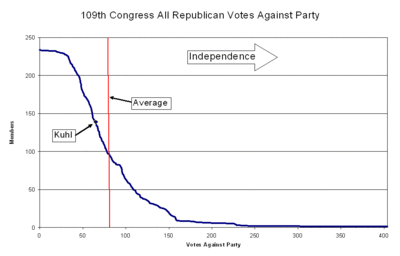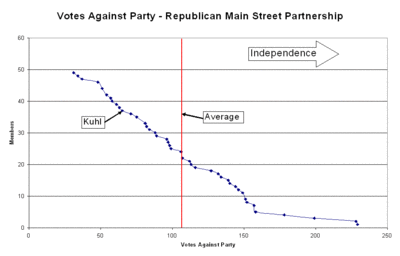Measuring Kuhl's Independence
Like all good political advertising, Randy Kuhl's new tag line -- "Accessible, Independent, Effective" -- sounds good and is hard to measure.
"Accessible" and "Effective" are subjective: Accessible to whom? Effective at what? I'll leave it to the reader to decide whether those components of Kuhl's slogan is true for them.
"Independent" is a little less tricky, because we can use the facts of Kuhl's voting record to measure it.
One common measurement of Kuhl's record is the claim that he votes with President Bush 93% of the time, which makes it sound like they're joined at the hip. But Congress votes a lot (the 109th has more than 1100 recorded votes), and most of those votes are for relatively minor, uncontested issues, like the naming of post offices or resolutions against cancer. Kuhl could argue, with some justification, that 93% isn't as close to Bush as it sounds.
Instead of an absolute percentage, let's compare Kuhl's votes to House Republicans in general. Kuhl's aso a member of the Republican Main Street Coalition, a centrist group that includes independents like John McCain in the Senate and fellow New Yorker Sherwood Boehlert in the House. Since Kuhl's predecessor Amo Houghton was a founding member of the coalition, it's worth seeing if Kuhl is keeping up the tradition of independence that this group represents.
The following graphs measure Kuhl's performance within these two peer groups. The horizontal (X) axis is the number of times a member has voted against the majority of his or her party. The vertical axis is the cumulative number of members who have a given number of "contrary" votes. Kuhl's position is clearly marked.
Another way of looking at these graphs is that the "pack" is on the left and the "rebels" are on the right. The farther right a member is plotted on the graph, the more independent (against the pack) they are.
This first graph shows where Kuhl stands in relation to the rest of Republicans. The red line represents the average number of times that a Republican votes against his or her party: 83 times. Randy Kuhl's 65 votes against the majority is well under that number. By that measure, he's less independent than average.
The second graph plots Kuhl's standing among the 49 members of the Republican Main Street Coalition. Kuhl's 65 contrary votes is far below the group average of 106. Kuhl's standing here is well within the bottom third of Main Street members.
The conclusion I draw from these numbers is that Kuhl's claim of independence is suspect at best. He votes with his party more than average, and far more than the average of a self-identified group of independents. In fact, in the New York Republican delegation, Kuhl is second only to Tom Reynolds in party loyalty.
-------------
Notes on the data: This report used the dataset of votes created by UCLA professors Jeff Lewis and Keith Poole, and limits votes to those taken prior to September, 2006. Any errors here are mine, not theirs.

